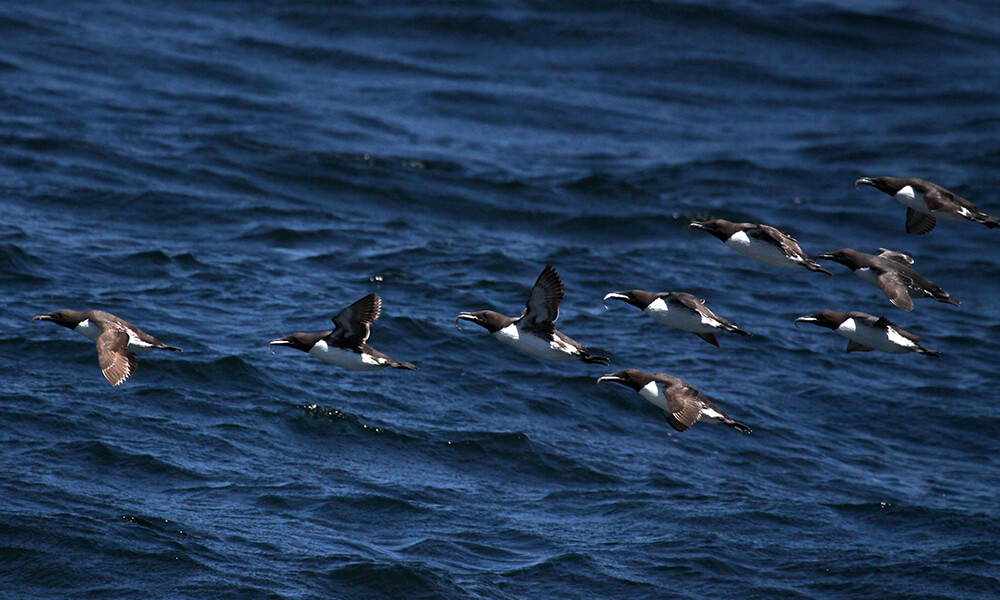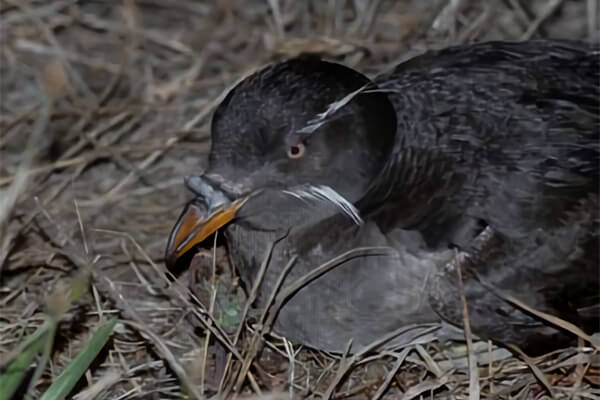Diving Seabirds

Facts about diving seabirds:
- Most prefer being in and under the water than flying in the air.
- These birds use their wings underwater as flippers to swim after prey like fish and krill.
- Many nest in burrows, only laying one egg per year, but some species lay two eggs.
- Both the male and female take care of the young birds.
- Diving birds have different plumage (feathers) during breeding and non-breeding seasons.
Common Murre (Uria aalge)

- Wingspan: 28 inches on average (just over two feet)
- Home breeding territory: Common murre breed on rocky cliffs and on offshore islands such as the Farallon Islands and islets off Point Reyes National Seashore.
- Clutch size: Murres lay one egg.
- Impacts: The common murre is often the species most affected by oil spills. They are also vulnerable to changes in the food web due to climate change.
- Status: The 2018 IUCN Red Lists states that common murres are of least concern.
- Fun fact: Murres are often studied as indicators of ecosystem health in nearshore marine ecosystems.
Cassin’s Auklet (Ptychoramphus aleuticus)

- Wingspan: Just over a foot, usually about 13.4 inches
- Home breeding territory: Cassin’s auklets nest in colonies on the Farallon Islands, on the Channel Islands, and on various other islands north to Alaska and south to Mexico.
- Clutch size: Cassin’s auklets lay one egg per year; however, unique to this species of auklets, they are able to “double-clutch” and produce one more successive egg if enough food is available.
- Impacts: Cassin’s auklets are specialist feeders on krill, so there is concern as to how their populations will fare following alteration of krill distribution and abundance in the face of climate change.
- Status: The 2018 IUCN Red List states that Cassin’s auklets are near threatened.
- Fun fact: This seabird is capable of diving to depths of 98 feet in search of food!
Rhinoceros Auklet (Cerorhinca monocerata)

- Wingspan: The average wingspan is just over 2 feet at 24.4 inches.
- Home breeding territory: Rhinoceros auklets breed on islands in the North Pacific from Japan to the Aleutians and in California, on Año Nuevo Island, the Farallon Islands, and the Channel Islands.
- Clutch size: One egg
- Impacts: Long-term changes in sea surface temperature due to climate change, predation by invasive species, and interactions with fisheries threaten rhinoceros auklets.
- Status: The 2018 IUCN Red Lists states rhinoceros auklets to be of least concern.
- Fun fact: As technology has improved, rhinoceros auklets are now being tracked via GPS off the California coast. Prior to this, their movements at sea were less well known, especially during the non-breeding season.
Tufted Puffin (Fratercula cirrhata)

- Wingspan: On average 25 inches, just over 2 feet.
- Home breeding territory:Most tufted puffins breed on the Aleutian Islands and Alaska Peninsula. In Northern and Central California, known breeding locations include Castle Rock, Green Rock, Flatiron Rock, Bird Rock, Point Reyes, South Farallon Islands, San Pedro Rock, and islets near Port San Luis.
- Clutch size: The tufted puffin lays a single white egg.
- Impacts: Tufted puffins are threatened by oil spills and reduced prey availability.
- Status: Tufted puffins are of least concern as of the 2018 IUCN Red List.
- Fun fact: They have the longest incubation period of any diving bird, approximately 45 days!
Click here for more information on pelagic seabirds of Cordell Bank National Marine Sanctuary

